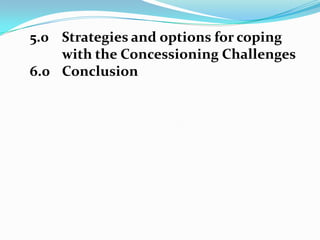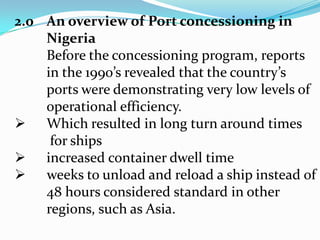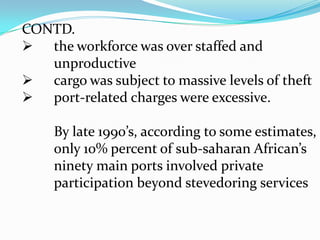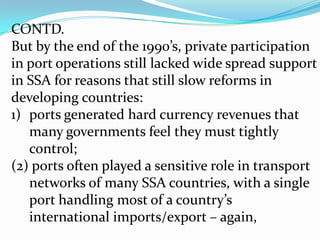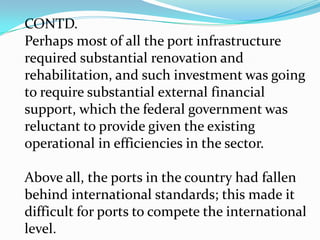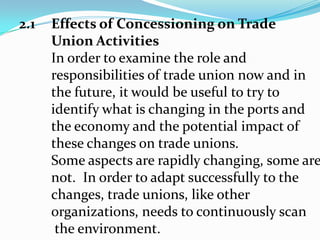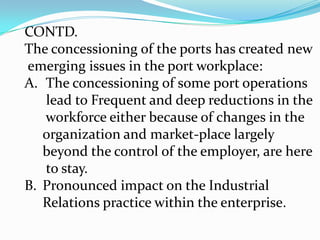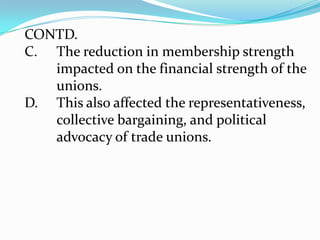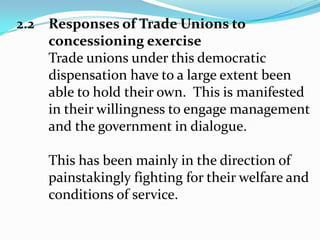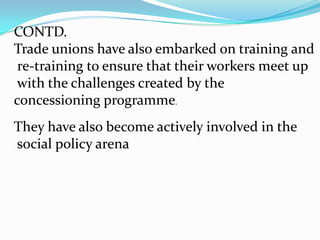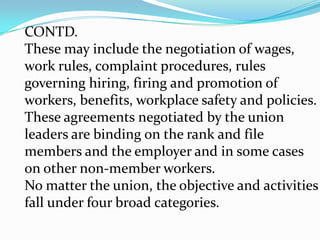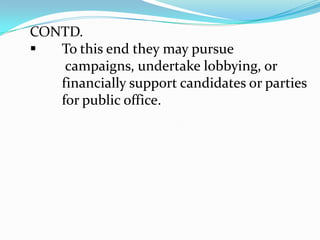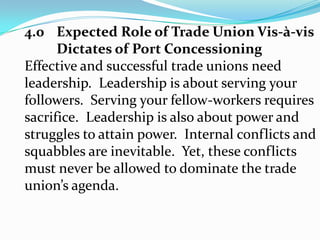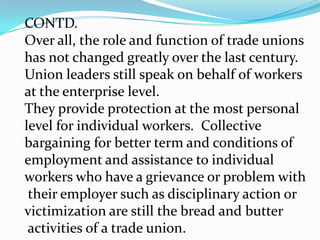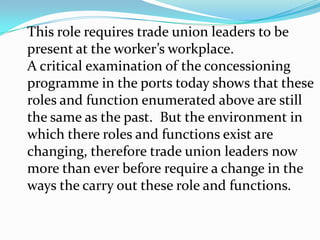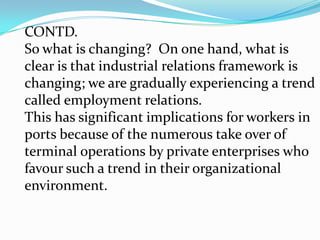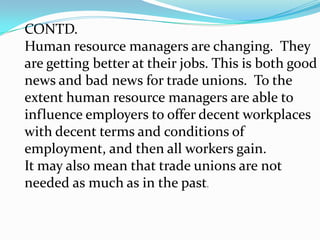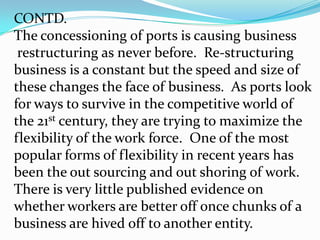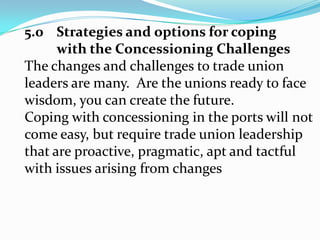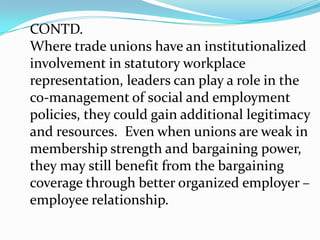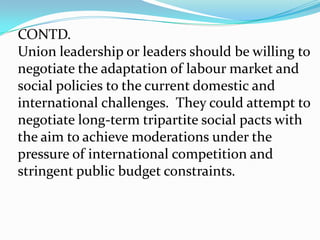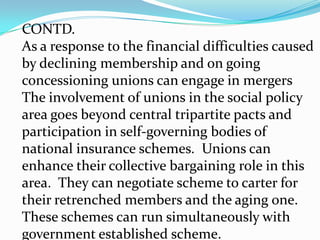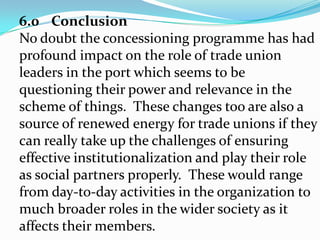The Role of trade Union in the Copntext of Port Concessioning
- 1. THE CHANGING ROLE OF TRADE UNION LEADER IN THE CONTEXT OF PORT CONCESSIONINGBYĚýOGHARANDUKU I. VICTORTraining and Development Officer IILabour-Management Relations DepartmentMichael Imoudu National Institute for Labour Studies, Ilorin
- 2. 1.0Preamble2.0 An overview of Post concessioning in Nigeria2.1 Effects of Concessioning on Trade Union Activities2.2 Responses of Trade Unions to concessioning exercise3.0 Traditional Role of Trade Unions Leaders4.0 Expected Role of Trade Union Vis-Ă -visDictates of Port Concessioning
- 3. 5.0Strategies and options for copingwith the Concessioning Challenges6.0 Conclusion
- 4. 1.0Preamble In September 2004, the government of Nigeria initiated one of the most ambitions infrastructure concessioning programs ever attempted. By July 2006, 20 long term port concession had been awarded (with six more in progress) to various private enterprises. The program was predicated on the need to remedy massive shortcomings in the sectorwhich were sharply inhibiting economic development.
- 5. 2.0 An overview of Port concessioning in NigeriaBefore the concessioning program, reports in the 1990’s revealed that the country’sports were demonstrating very low levels of operational efficiency. Which resulted in long turn around timesfor ships increased container dwell time
- 6. weeks to unload and reload a ship instead of48 hours considered standard in other regions, such as Asia.
- 7. CONTD.the workforce was over staffed and unproductive cargo was subject to massive levels of theft
- 8. port-related charges were excessive. By late 1990’s, according to some estimates,only 10% percent of sub-saharan African’s ninety main ports involved private participation beyond stevedoring services
- 9. CONTD.But by the end of the 1990’s, private participationin port operations still lacked wide spread support in SSA for reasons that still slow reforms in developing countries: ports generated hard currency revenues that many governments feel they must tightly control; (2) ports often played a sensitive role in transport networks of many SSA countries, with a single port handling most of a country’s international imports/export – again,
- 10. CONTD. government officials sometimes see private participation as diminishing their control;3) ports have enjoyed strong growth in volume of containerized traffic (over 9 percent annually in SSA during the 1990’s) regardless of whether the efficiency of their operations has improved; and 4) with strong growth in container traffic, and often relieve of the responsibility for servicing debt needed for investments, government-managed ports sometimes showpositive, if mis- leading, profit performance.
- 11. CONTD.Perhaps most of all the port infrastructurerequired substantial renovation and rehabilitation, and such investment was goingto require substantial external financialsupport, which the federal government was reluctant to provide given the existingoperational in efficiencies in the sector.Above all, the ports in the country had fallen behind international standards; this made it difficult for ports to compete the international level.
- 12. CONTD. These have serve implications for revenue to the nation.
- 13. 2.1 Effects of Concessioning on Trade Union ActivitiesIn order to examine the role and responsibilities of trade union now and in the future, it would be useful to try to identify what is changing in the ports and the economy and the potential impact of these changes on trade unions. Some aspects are rapidly changing, some are not. In order to adapt successfully to the changes, trade unions, like other organizations, needs to continuously scan the environment.
- 14. CONTD.The concessioning of the ports has created newemerging issues in the port workplace:The concessioning of some port operations lead to Frequent and deep reductions in theworkforce either because of changes in the organization and market-place largely beyond the control of the employer, are hereto stay. Pronounced impact on the Industrial Relations practice within the enterprise.
- 15. CONTD.C.The reduction in membership strength impacted on the financial strength of the unions.D.This also affected the representativeness, collective bargaining, and political advocacy of trade unions.
- 16. 2.2 Responses of Trade Unions to concessioning exercise Trade unions under this democratic dispensation have to a large extent been able to hold their own. This is manifestedin their willingness to engage management and the government in dialogue. This has been mainly in the direction of painstakingly fighting for their welfare and conditions of service.
- 17. CONTD.Trade unions have also embarked on training andre-training to ensure that their workers meet upwith the challenges created by the concessioning programme.They have also become actively involved in the social policy arena
- 18. 3.0 Traditional Role of Trade Unions Leaders Briefly put, trade unions are organizations of workers who have boarded themselves to achieve common goals in key areas and working conditions. The trade union through its leadership, bargains with the employer on behalf of union members (rank and file members) and negotiates labour contracts (collective bargaining) with employers.
- 19. CONTD.These may include the negotiation of wages,work rules, complaint procedures, rules governing hiring, firing and promotion of workers, benefits, workplace safety and policies.These agreements negotiated by the union leaders are binding on the rank and file members and the employer and in some caseson other non-member workers.No matter the union, the objective and activitiesfall under four broad categories.
- 20. Provision of benefits to members
- 21. Collective bargaining: where trade unions are able to openly and are recognized by employers. Industrial Action: Trade unions may enforce strikes or resistance to lock outs in furtherance of particular goals. Political Activity: Trade unions may promote legislations favourable to the interest of theirmembersor workers as awhole.
- 22. CONTD. To this end they may pursue campaigns, undertake lobbying, or financially support candidates or parties for public office.
- 23. 4.0 Expected Role of Trade Union Vis-à -vis Dictates of Port ConcessioningEffective and successful trade unions needleadership. Leadership is about serving yourfollowers. Serving your fellow-workers requiressacrifice. Leadership is also about power and struggles to attain power. Internal conflicts and squabbles are inevitable. Yet, these conflicts must never be allowed to dominate the trade union’s agenda.
- 24. CONTD.Leaders need to have a strong sense of direction.They must decide where they want their organization to be in five years time. They must decide how to get to that destination. They must decide who going to do what. What driventhe future? Is it a respect of the strategies and tactics of the past? No! The future is driven byinnovation.
- 25. CONTD.Over all, the role and function of trade unionshas not changed greatly over the last century. Union leaders still speak on behalf of workers at the enterprise level. They provide protection at the most personal level for individual workers. Collective bargaining for better term and conditions of employment and assistance to individual workers who have a grievance or problem withtheir employer such as disciplinary action or victimization are still the bread and butteractivities of a trade union.
- 26. This role requires trade union leaders to be present at the worker’s workplace.A critical examination of the concessioning programme in the ports today shows that theseroles and function enumerated above are still the same as the past. But the environment in which there roles and functions exist are changing, therefore trade union leaders now more than ever before require a change in the ways the carry out these role and functions.
- 27. CONTD.So what is changing? On one hand, what is clear is that industrial relations framework is changing; we are gradually experiencing a trendcalled employment relations. This has significant implications for workers inports because of the numerous take over of terminal operations by private enterprises who favour such a trend in their organizationalenvironment.
- 28. CONTD.Another change confronting union is the “deunionisation” and its consequences for collecting bargaining and the political clout ofunion movement have become a problem acknowledged not only in academic but also union cycles.
- 29. CONTD.Human resource managers are changing. They are getting better at their jobs. This is both goodnews and bad news for trade unions. To the extent human resource managers are able to influence employers to offer decent workplaces with decent terms and conditions of employment, and then all workers gain. It may also mean that trade unions are not needed as much as in the past.
- 30. CONTD.
- 31. CONTD.The concessioning of ports is causing businessrestructuring as never before. Re-structuring business is a constant but the speed and size of these changes the face of business. As ports lookfor ways to survive in the competitive world of the 21st century, they are trying to maximize the flexibility of the work force. One of the mostpopular forms of flexibility in recent years hasbeen the out sourcing and out shoring of work. There is very little published evidence on whether workers are better off once chunks of a business are hived off to another entity.
- 32. 5.0Strategies and options for coping with the Concessioning ChallengesThe changes and challenges to trade union leaders are many. Are the unions ready to facewisdom, you can create the future. Coping with concessioning in the ports will notcome easy, but require trade union leadershipthat are proactive, pragmatic, apt and tactful with issues arising from changes
- 33. CONTD.Where trade unions have an institutionalized involvement in statutory workplace representation, leaders can play a role in the co-management of social and employment policies, they could gain additional legitimacyand resources. Even when unions are weak inmembership strength and bargaining power,they may still benefit from the bargaining coverage through better organized employer – employee relationship.
- 34. CONTD.Union leadership or leaders should be willing tonegotiate the adaptation of labour market andsocial policies to the current domestic and international challenges. They could attempt to negotiate long-term tripartite social pacts with the aim to achieve moderations under the pressure of international competition and stringent public budget constraints.
- 35. CONTD.As a response to the financial difficulties causedby declining membership and on goingconcessioning unions can engage in mergersThe involvement of unions in the social policy area goes beyond central tripartite pacts and participation in self-governing bodies of national insurance schemes. Unions can enhance their collective bargaining role in this area. They can negotiate scheme to carter for their retrenched members and the aging one. These schemes can run simultaneously with government established scheme.
- 36. 6.0 ConclusionNo doubt the concessioning programme has hadprofound impact on the role of trade union leaders in the port which seems to bequestioning their power and relevance in the scheme of things. These changes too are also a source of renewed energy for trade unions if they can really take up the challenges of ensuring effective institutionalization and play their role as social partners properly. These would range from day-to-day activities in the organization tomuch broader roles in the wider society as itaffects their members.
- 37. THANK YOU


